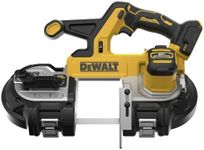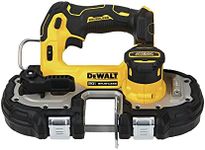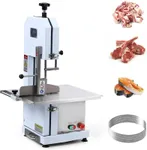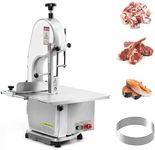Buying Guide for the Best Benchtop Bandsaws
Choosing the right benchtop bandsaw can make a significant difference in your woodworking projects. A benchtop bandsaw is a versatile tool that allows you to make precise cuts, curves, and resawing tasks. To find the best fit for your needs, it's important to understand the key specifications and how they impact the performance and usability of the bandsaw. Here are the key specs you should consider when selecting a benchtop bandsaw.Motor PowerThe motor power of a benchtop bandsaw is measured in horsepower (HP) or amps. This spec determines how powerful the saw is and how easily it can cut through different types of wood. For light-duty tasks and softwoods, a motor with lower power (around 0.5 to 1 HP) may suffice. For more demanding tasks, such as cutting hardwoods or thick materials, a motor with higher power (1 to 1.5 HP or more) is recommended. Consider the types of projects you plan to undertake and choose a motor power that matches your needs.
Throat CapacityThe throat capacity is the distance between the blade and the vertical frame of the saw. This spec determines the maximum width of material you can cut. A larger throat capacity allows you to work with wider pieces of wood. For general woodworking, a throat capacity of 9 to 12 inches is usually sufficient. If you plan to work with larger pieces, look for a bandsaw with a greater throat capacity. Assess the typical size of your projects to determine the appropriate throat capacity for your needs.
Cutting HeightThe cutting height, also known as the resaw capacity, is the maximum height of material that the bandsaw can cut. This is important for tasks such as resawing lumber into thinner pieces or cutting thick blocks of wood. For most hobbyist projects, a cutting height of 6 inches is adequate. However, if you plan to do a lot of resawing or work with thicker materials, you may want a bandsaw with a cutting height of 8 inches or more. Consider the thickness of the materials you will be working with to choose the right cutting height.
Blade WidthThe blade width refers to the range of blade sizes that the bandsaw can accommodate. Different blade widths are suitable for different types of cuts. Narrow blades (1/8 to 1/4 inch) are ideal for making tight curves and intricate cuts, while wider blades (1/2 to 3/4 inch) are better for straight cuts and resawing. A bandsaw that can accommodate a variety of blade widths offers greater versatility. Think about the types of cuts you will be making most often and choose a bandsaw that supports the appropriate blade widths.
Table Size and TiltThe size of the bandsaw table affects the stability and support of the material being cut. A larger table provides more support for larger pieces of wood. Additionally, the ability to tilt the table allows for angled cuts. Most benchtop bandsaws offer a table tilt of up to 45 degrees. For general use, a table size of around 12 x 12 inches is common, but larger tables can be beneficial for bigger projects. Consider the size of the materials you will be working with and whether you need to make angled cuts to determine the right table size and tilt capability.
Blade SpeedBlade speed, measured in feet per minute (FPM), affects the cutting performance and finish. Higher speeds are suitable for cutting softer materials and achieving smoother finishes, while lower speeds are better for harder materials and more controlled cuts. Some bandsaws offer variable speed settings, allowing you to adjust the speed based on the material and type of cut. If you work with a variety of materials, a variable speed bandsaw can be very useful. Consider the types of materials you will be cutting and whether variable speed is important for your projects.
Dust CollectionDust collection is an important feature for maintaining a clean and safe workspace. Many benchtop bandsaws come with a dust port that can be connected to a shop vacuum or dust collection system. This helps to minimize sawdust and debris, improving visibility and reducing the risk of respiratory issues. If you value a clean workspace, look for a bandsaw with an effective dust collection system. Consider the importance of dust management in your workshop and choose a bandsaw with appropriate dust collection features.




















